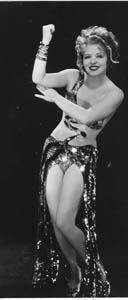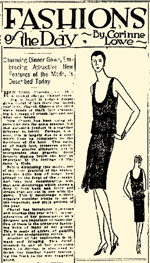By Sharon Boswell
and Lorraine McConaghy
Special to The Times
 In 1922, 17-year-old Clara Bow won a fan-magazine contest as "The Most Beautiful Girl in the World."
She hit the silver screen with films like "Mantrap," but her greatest movie sensation was "It," released in 1927.
Billed as "The It Girl," Clara Bow personified the glamorous American woman.
In 1922, 17-year-old Clara Bow won a fan-magazine contest as "The Most Beautiful Girl in the World."
She hit the silver screen with films like "Mantrap," but her greatest movie sensation was "It," released in 1927.
Billed as "The It Girl," Clara Bow personified the glamorous American woman.
Photo Credit: Seattle Times.
During the 1920s, the American people were scandalized and fascinated by the nation's new young women.
In Seattle, local moralists lifted their hands in horror as girls literally threw off their restraints,
tossing away their corsets and fleeing their country homes for new jobs and apartments in the city.
From Seattle to Portland, Auburn to Kirkland, the economy quickened, opening new opportunities
to women in factory and office. The 19th Amendment to the Constitution had assured women the right to vote in
federal elections.
Many of the old restrictions on women's behavior had gone the way of the horse and buggy.
Politically equal, economically self-reliant, socially free -- what direction would liberated women take?
Who was the new young woman of the '20s?
Was she the capable girl who had worn a uniform during the war, and strode into the new decade
as a self-assured career woman? Was she the working girl, bent over the assembly line or selling lingerie at the
counter? Was she the kittenish flapper whose bobbed hair and short skirt raised eyebrows as she sped her roadster
around town?
Was she the young housewife who earnestly studied nutrition and child-rearing, feeding her
family bran and yeast in a well-balanced diet? Was she a student at the university, bright and ambitious,
pretty and full of fun -- Phi Beta Kappa and the sweetheart of Sigma Chi? Or was she the scheming homewrecker
whose sultry charms lured men from their humdrum marriages and workaday lives?
Career woman, working girl, flapper, housewife, co-ed, vamp -- The Times celebrated the new women
because they made good copy and were good customers, but the newspaper was unwilling to go too far in promoting their
new ways of life.

In 1921, University of Washington co-eds -- and their house-mother -- pose on the grass in front of their Clarke Hall
dorm.
Photo Credit: Special Colls., UW Libraries
In a world where fewer women sewed their own clothes, put up their own vegetables or baked their
own bread, Times ads offered ready-to-wear frocks, canned beans and Holsum Bread, direct from the bakery. Ads for
electrical appliances -- from irons to washing machines to vacuum cleaners -- promised to relieve the drudgery
of housework. The new "painted women" purchased rouge and lipstick, mascara and nail polish, powder and perfume;
they streamed to beauticians to have their hair cut and styled.
Week after week, The Times' Women's Page promoted a careful blend of the old values and the new:
hearth and home, careerism, voluntarism. Recipes for quick breads and hints for removing stains from teacups were
printed alongside tasteful ads from the city's most exclusive shops for the newest Paris fashions.
The Times' society editor -- one of very few women working in the newsroom -- lovingly reported
the teas, musicales and garden parties of Seattle's debutantes and matrons.
The newspaper gave enthusiastic coverage to young women athletes, musicians and scholars;
it celebrated "bachelorettes" who lived alone and worked hard to earn a living. Portraits of University of
Washington sorority girls ran side-by-side with wedding portraits of ingenues; a weekly photo feature pictured
society mothers with their children.
At the beginning of the decade, every comic in the Sunday edition of The Seattle Times was a
domestic comedy, such as "Mr. and Mrs." or "Bringing Up Father." By mid-decade, "Betty" and "Winnie Winkle,
The Breadwinner" joined these old stand-bys, celebrating the fun and independence of single young women.
 The Chanel look sheared women's flowing curls and demanded a slim, almost boyish figure.
The Times ran a fashion column that covered the new Paris couture. Women spent money freely on clothing,
makeup and convenience foods. Here, an ad cautions women that making mayonnaise from scratch is difficult
and tedious -- better buy it at the store.
The Chanel look sheared women's flowing curls and demanded a slim, almost boyish figure.
The Times ran a fashion column that covered the new Paris couture. Women spent money freely on clothing,
makeup and convenience foods. Here, an ad cautions women that making mayonnaise from scratch is difficult
and tedious -- better buy it at the store.
But the '20s also titillated Seattle readers with sordid "love crimes" and "nights of illicit
passion" as The Times brought front-page coverage to splashy divorces in high life.
Dozens of Times features promised the lurid details about the private lives of the new young women,
offering teasing titles like "Love for Sale?" "Giving Her All," or "Confessions of The Other Woman."
Local movie houses offered Hollywood's biggest stars playing in hot movies called "Jazz Babies,"
"Cheap Kisses," "Men and Women," and -- finally -- simply "SEX."
The Times led a long campaign to raise salaries for the state's teachers -- nearly all women --
and generally encouraged women's new financial independence. But the newspaper also worried in print about
the social consequences of the revolution in women's rights and opportunities.
Washington, the paper declared with dismay, had become a divorce mill, tripling Reno's rate,
and children would become the victims of their mothers' new freedom. In the newspaper, the thrilling romance
of the new women continued throughout the decade to vie with sentimental nostalgia for the meek and
loving homebodies of the past.
Historians Sharon Boswell and Lorraine McConaghy teach at local universities and do research,
writing and oral history. Original newspaper graphics courtesy of the Seattle Public Library.